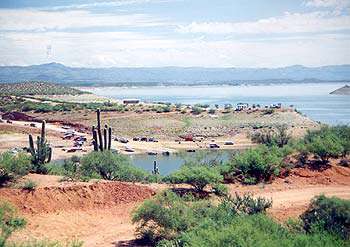San Carlos Lake Fishing
category : Fishing
 San Carlos Lake Bass and Crappie Flourish
San Carlos Lake Bass and Crappie Flourish— by Craig Springer (USFWS)
Arizona's San Carlos Lake has a storied past of producing big bass. Those yarns usually start with "I remember when . . ."
Lament no more — the good old days are the here and now.
Recent largemouth bass population electrofishing surveys done by the U.S. Fish & Wildlife Service's Arizona Fishery Resources Office (AZFRO) and the San Carlos Apache Recreation & Wildlife Department Game Rangers show that bass anglers should have no reason to yearn for yesterday. Three nights of electrofishing surveys on San Carlos Lake turned up 1,000 largemouth bass, not by any means all the bass that live in the lake. On average, these fish are big: 18 inches long and three pounds. AZFRO fishery biologist, Mark Brouder, says the population looks healthy and the future looks good, too.
AZFRO biologist, Dewey Wesley, hangs onto a San Carlos Lake largemouth caught by electrofishing. Photo Mark Brouder/USFWS
"Overall, this largemouth bass population is balanced," said Brouder. "We've got good proportions of both younger and older bass showing up in our surveys. That bodes well for fishing now, and down the road." Based on survey results, 23 percent of all bass collected were 15 inches or longer; 10 percent were longer than 20 inches. If you want to tussle with a trophy bass, chances are not so bad. Five percent of all the largemouths caught on the population surveys were bigger than 25 inches. These biggest bass averaged eight pounds, but Brouder reports that six largemouth bass tipped his scales at over 10 pounds, with the largest fish going two feet long and 11.5 pounds.
There's a value-added fish at San Carlos Lake, black crappie. While electrofishing targets bass, Brouder's crew also turned up 100 crappie — double what they normally catch. These crappies averaged 13 inches long and 1.5 pounds. The biggest measured 19 inches long and 2.5 pounds. Like the bass population, Brouder says the San Carlos Lake crappie population is balanced, but with proportionally more trophy-sized crappie — 15 inches or bigger. About 83 percent of the crappie are longer than 12 inches. That's what's there now. But Brouder is excited, too, about future crappie fishing: "What's also encouraging is we caught two distinct year-classes of crappie. That means anglers will be boating plenty of two to three-pounders over the next three years."
If the stories of yore have you yenning for more, the time is now to quench that craving for big bass and crappie.
To learn more about the San Carlos Lake fishery, contact Mark Brouder at (928) 475-2554; mark_brouder@fws.gov
The AZFRO works with Tribal, state, federal and private partners to restore and manage fisheries from its four offices in Arizona: Pinetop, San Carlos, Parker, and Flagstaff. AZFRO is one of 64 Fishery Resources Offices located in U.S. The U.S. Fish & Wildlife Service also manages 70 national fish hatcheries, nine Fish Health Centers, and seven Fish Technology Centers across the country that conserve fishes and their habitat for the benefit and enjoyment of the American people.
Copyright© 2003, USFWS, All rights reserved.
Admission: Permits Required
Address: 25 miles E of Globe, AZ on SR 70, 9 miles S on R 3
Phone: 928-475-2554
Our Email: mark_brouder@fws.gov
Call during low water conditions.
Come visit us in San Carlos Lake, Arizona